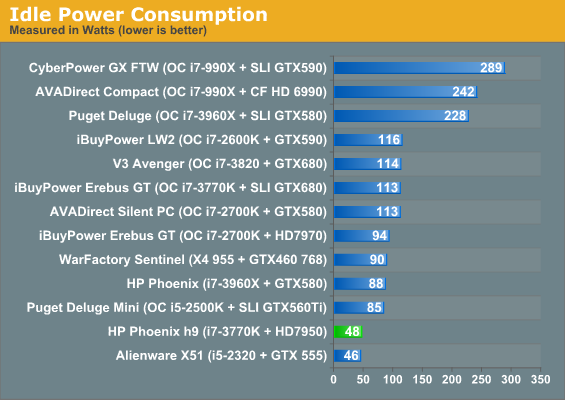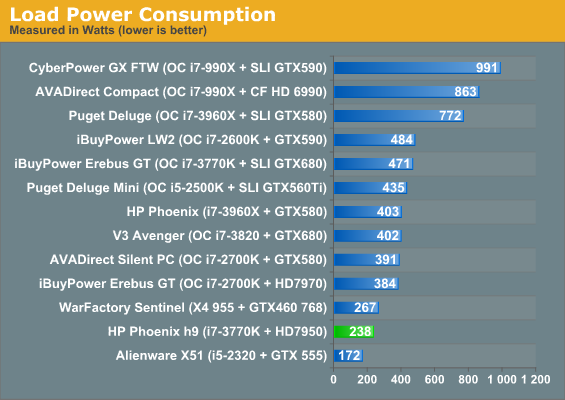HP Phoenix h9-1120t System Review: HP's Gaming Desktop Round Two with Tahiti and Ivy Bridge
by Dustin Sklavos on June 19, 2012 8:15 PM EST- Posted in
- Systems
- Gaming
- AMD
- HP
- Ivy Bridge
- Radeon HD 7000
- Phoenix
- Tahiti
Build, Heat, and Power Consumption
We already covered the HP Phoenix chassis in our previous review; the chassis itself hasn't changed at all and features the same modest expandability and thermal envelope. I still quite like the design; it's a little bit gaudy but not overly so, though last time many of you were unimpressed. It's a matter of taste. HP also continues to standardize the Phoenix on a single 80mm closed loop liquid-cooler that's reasonably efficient but not liable to win any awards, and it's definitely a step down from the 92mm configuration in iBuyPower's LAN Warrior.
I took the opportunity this time to check out the overclocking options in the HP Phoenix h9, though. What I found was...more than I expected, but much less than I'd hoped for. There's ratio control, and you can enable the IGP in the BIOS if you're like me and want access to either the extra monitor outputs and/or Quick Sync, but tweaking is extremely limited. When overclocking, you're entirely at the mercy of however HP's system handles voltage, and given how sensitive Ivy Bridge can be you're almost better off either keeping the overclock extremely modest or just foregoing it entirely. This is a service that HP could be providing from the factory, but they don't, and it's to their detriment.

Thankfully there does seem to be a healthy amount of thermal headroom. At stock clocks and voltages, Ivy Bridge runs nice and frosty, and even the Radeon HD 7950 is able to keep temperatures comparatively low. This is one place where HP's Phoenix does excel and threaten boutique builds, though mostly it's because they're not pushing the envelope at all.


Power consumption is the other. The newer Phoenix has outstandingly low idle and load power draw for its performance profile, and I think the boutiques would have a hard time competing with this. In situations where the extra CPU cores aren't needed, the Phoenix h9 nips at the heels of the vastly more expensive Sandy Bridge-E version while drawing a hair over half of the power from the wall.


_thumb.jpg)
_thumb.jpg)
_thumb.jpg)
_thumb.jpg)
_thumb.jpg)
_thumb.jpg)








33 Comments
View All Comments
flamethrower - Tuesday, June 19, 2012 - link
A pre-built micro-ATX based performance system. To me this means $800 to $1500 excluding monitor. Enthusiast systems like this don't interest me much.Have I been missing your coverage of this type of system? Should I look at laptops if I only need a performance-class system?
cashkennedy - Tuesday, June 19, 2012 - link
So this pre-built , micro-atx equivalent (same size) performance system that ranges from 1000-1700 clearly has nothing in common with what you are interested in...What do you mean by performance class? Cause you can order this with a crap video card for 999 and it would no longer be a gaming class if thats what you consider this...
ImSpartacus - Tuesday, June 19, 2012 - link
I think he's referencing the argument that OEMs should play to their strengths and not try to compete with homemade systems.Enthusiasts can easily make cheap, tweakable, expandable performance-first systems. OEMs have no chance of seriously competing in that space.
But OEMs CAN appeal to the enthusiast by providing a product that the enthusiast cannot get anywhere else. Machines like the Alienware X51 and almost every mini-ITX HTPC are examples.
flamethrower is asking for something in the middle.
Etern205 - Wednesday, June 20, 2012 - link
One area DIY can't compete to OEM is the OS. If someone can only spend $1000 on a gaming build, then shelling out $100 means, they will have to get a less powerful graphic card, not like a GTX 670 or HD7950.BTW, I tried to configure a simlar PC from newegg to as close as possible the system review in this article, and total comes out to $1,530, and that also includes the OS.
bah12 - Wednesday, June 20, 2012 - link
Keep in mind that Microsoft's OEM license for $99 is not legal to use on your own machine. Load's of us do it, but from a strictly legal perspective using an OEM licence on a DIY build is not compliant with the terms of the licence. The only licence Microsoft sells for a "naked" PC is full retail, so in reality you should price in a $299 OS not $99. But who's going to do that really :)Einy0 - Wednesday, June 20, 2012 - link
You are somewhat correct in that notion, the license clearly states that an OEM license is for a new PC and must be sold to a third party. It purposely does not place other obstructions on the license, in order to allow knowledgeable PC people to build systems themselves for reasonable licensing fees. If they did not intend this they would make more restrictions on the license. An example would be the "system builder" would need to a be a qualified and licensed business or employee of such a business. Legally, I could have my wife purchase the software, install it on a new PC and sell it to me for $1. The key restriction here is the software lives and dies with the PC. Microsoft considers the motherboard to be the key item in that transaction and even then there are concessions for failed components.From MS Licensing:
e. To distribute the Software or Hardware in this Pack, you must be a System Builder
and accept this license. “System Builder” means an original equipment manufacturer, an assembler, a refurbisher, or a software
pre-installer that sells the Customer System(s) to a third party.
Pricing the OS at $299 in a complete system build would
be just plain idiotic. If MS enforced $299 an OS, they would kill their market overnight! People would find alternatives quickly...
Zink - Tuesday, June 19, 2012 - link
To me a performance system would need an SSD and this case is about 2" higher than other mATX systems because of the non-standard power supply and case design.If performance-class means mediocre gaming ability then I think a laptop is a great way to go. Intel quads hit 3.5Ghz and have 80% of the performance of the quad desktop i7s.
flamethrower - Wednesday, June 20, 2012 - link
You cannot edit your posts on here. I got distracted by the lead-in about the $2900 system. This is a midrange system after all.bigboxes - Wednesday, June 20, 2012 - link
Maybe you should RTFA next time before giving a knee-jerk response.JeBuSBrian - Tuesday, June 19, 2012 - link
How is it that the mainstream system builders always seem to make their gaming rigs so fugly?